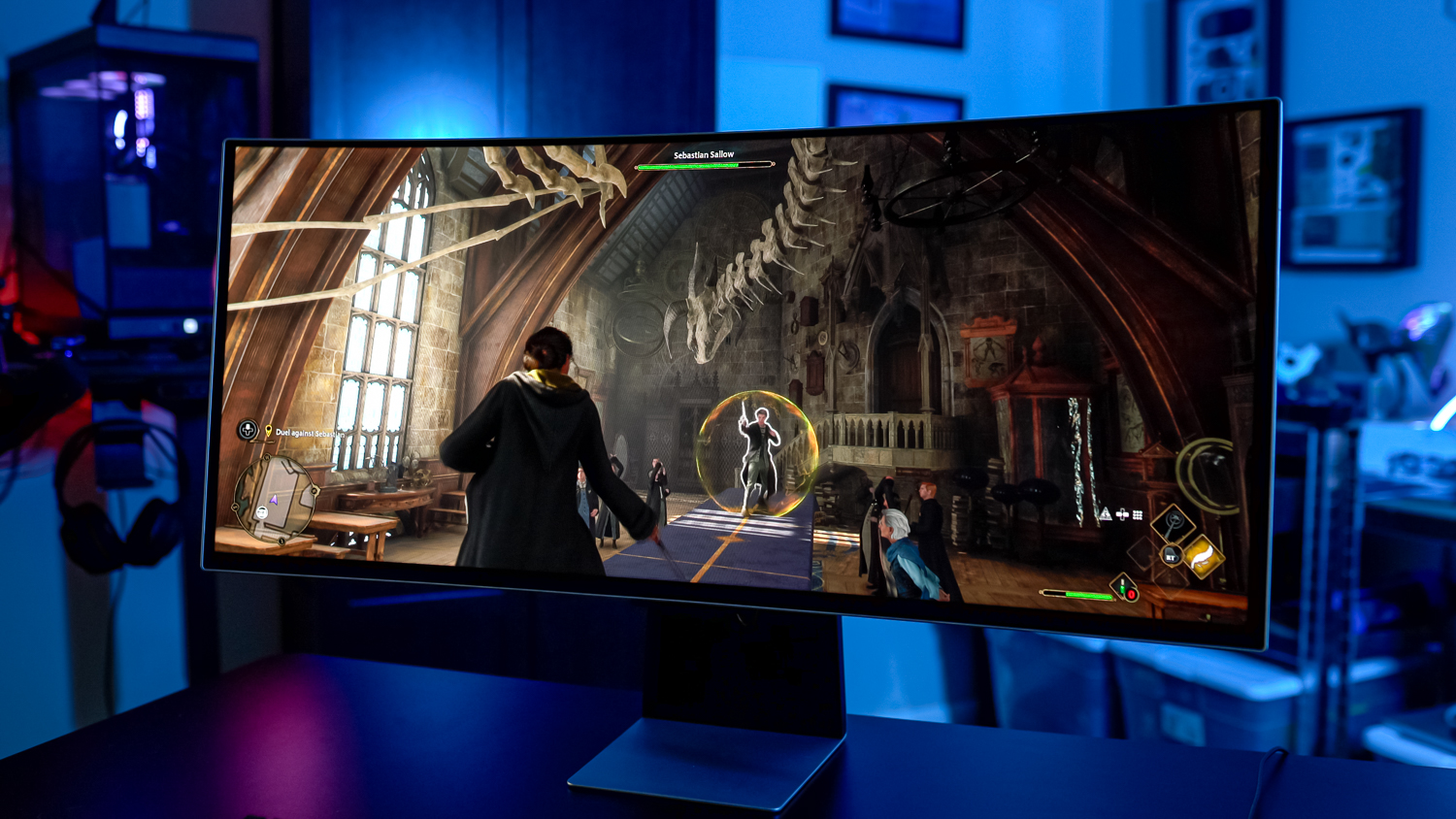
Samsung Odyssey OLED G8
MSRP $1,500.00
“Even at a higher price, the Samsung Odyssey OLED G8 manages to sweep the competition.”
Pros
- Exceptional color and HDR
- Ultrathin
- USB-C power delivery
- Dense settings in the OS
Cons
- More expensive than the competition
- Limited to mini connections
I thought the Samsung Odyssey OLED G8 was doomed to fail. I was sure that it would deliver image quality worthy of inclusion in our roundup of the best gaming monitors, but arriving late to the market and with a premium over similar displays, it looked dead on arrival.
I was wrong.
It’s not worth the list price Samsung originally set, but the Odyssey OLED G8 does a lot with its software to stand out from the crop of similar OLED displays that are available for cheaper prices. Combined with an attractive minimalist design and some of the best color coverage I’ve seen out of a display, the Odyssey OLED G8 is worth the premium.
Samsung Odyssey OLED G8 specs
| Samsung Odyssey OLED G8 | |
| Screen size | 21:9 34 inches |
| Panel type | QD-OLED |
| Resolution | 3,440 x 1,440 |
| Peak brightness | 250 nits (SDR) |
| HDR | DisplayHDR True Black 400 |
| Local dimming | 4,953,600 dimming zones |
| Contrast ratio | 1,000,000:1 |
| Response time | 0.03ms (GtG) |
| Refresh rate | 175Hz |
| Curve | 1,800R |
| Speakers | Yes |
| Inputs | Mini-DisplayPort 1.4, Micro HDMI 2.1, 2x USB-C w/ 65W power delivery |
| Ports | N/A |
| List price | $1,500 |
A striking design
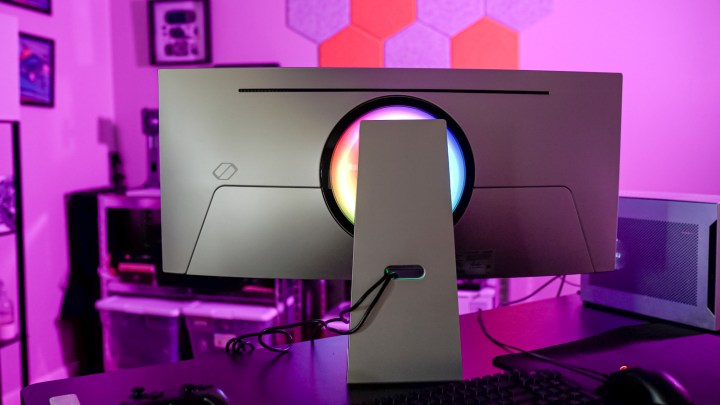
Samsung’s gaming monitors have never looked bad, but there’s something about the OLED G8 that makes it feel like the company has finally hit its stride. It’s the perfect balance of the minimalist, modern aesthetic that Samsung has cultivated with its TVs, combined with just enough flair to make it clear that this is a gaming monitor.
Those ideas clash, but Samsung makes them work together. The CoreSync lighting ring, which illuminates the area around where the stand connects, is fed through a darkened diffusion layer, helping it blend in with the stark silver on the back of the display. The stand helps with the minimalist feel, freeing up desk space compared to the Odyssey Neo G8 and offering plenty of coverage for your cables.
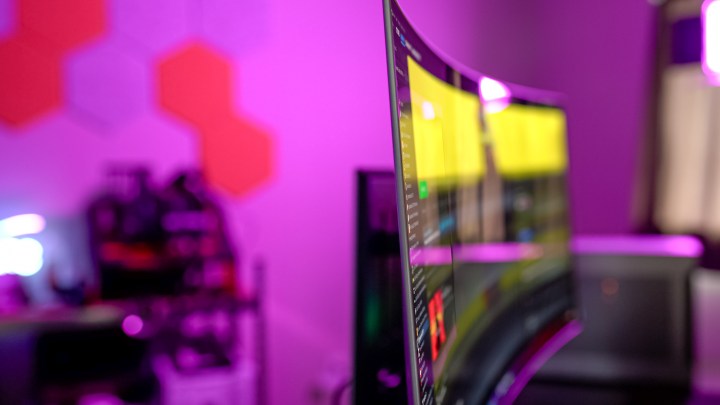
The thing I like most about the OLED G8, though, is how thin it is. We’ve seen plenty of thin OLED gaming monitors, even with a screen as large as on the LG UltraGear OLED 45, but they’re always accompanied by a thick brick on the back that houses all of the guts of the display. Samsung has miraculously made that brick vanish.
The front of the display looks equally as good, with thin bezels and only a hairs-length of border from the shell of the display. It feels like one of those impossible designs you see in a sample scene at Ikea. But then you turn the OLED G8 on and realize its one of the best-looking gaming monitors money can buy.
What’s with the mini ports?

I just heaped praise on the OLED G8, but it’s time to bring it back down to earth. Unboxing and setup was simple, especially due to how thin the screen is. Samsung is one of the few monitor brands that doesn’t pack the display with extraneous packaging, shrinking the box size down considerably — a small but important note for a 34-inch ultrawide display.
The two-part stand snaps into the display, you lift the whole thing out of the box, and you’re done. My only quibble with the setup was the base of the stand, which requires you to screw in two pre-threaded screws. It’s not a fully tool-less setup, but at the very least, you don’t need to hunt around the box for the two screws you need.
All set up, the stand is sturdy and provides a convenient cable-routing channel. As mentioned, it doesn’t take up a ton of desk space, either. The only problem is the limited range of adjustment, with the stand only offering height and tilt adjustments, not pivot or swivel. Thankfully, you can yank it off the stand and use a standard 100 x 100 VESA mount with a monitor arm.

That brings us to the bad: the ports. The display includes one DisplayPort 1.4 port, one HDMI 2.1 port, and two USB-C ports that can deliver up to 65 watts of power. The DisplayPort connection is Mini-DisplayPort, though, while the HDMI port is Micro HDMI.
I don’t know what Samsung was thinking here. Even on gaming laptops, it’s rare to find these connections over their full-size counterparts, and there’s plenty of space on the OLED G8 for a full port selection. Samsung includes a Mini-DisplayPort to DisplayPort cable in the box, but not a Micro HDMI cable. For a $1,500 gaming monitor, the least Samsung could do is include cables for all of the connections in the box, especially when it’s using such foreign ports.
Samsung also doesn’t include any extra USB connections or a headphone jack, so you can’t use it as a hub for your peripherals. The built-in Bluetooth connection gets around this issue, but that doesn’t help if you use wired peripherals.
The best QD-OLED monitor we’ve seen

There aren’t a lot of surprises with the OLED G8, mainly due to the fact that it uses the same panel as the Alienware 34 QD-OLED. But that doesn’t make the OLED G8 any less impressive. It looks stunning for any form of media you can throw at it, with perfect black levels thanks to the OLED panel and vibrant colors.
In SDR, the color coverage is exceptional. You’re getting 100% sRGB, of course, but also a chart-topping 99% coverage of DCI-P3 and 94% coverage of AdobeRGB. At full brightness, the monitor was also very accurate in SDR, offering a color error of only 0.8 (anything under 2 is considered suitable for color work).
The Samsung Odyssey OLED G8 can deliver bright highlights for small portions of the screen.
The weakness of the OLED G8, and all OLED panels, is the low peak brightness. The monitor topped out at 248 nits for the full screen in SDR, which is in line with other OLED monitors I’ve tested. It’s better than the LG UltraGear OLED 27 and matches Alienware’s 34 QD-OLED.
I never had an issue with brightness, even in a room with a decent amount of ambient light. This is a monitor that you want to run at or close to its maximum brightness most of the time, and the range of 200 to 250 nits is perfect for extended use. That’s especially due to the fact that this is a QD-OLED monitor. As the brightness decreases, however, colors are washed out in a layer of gray, making the display much less color accurate. The exceptional color accuracy at full brightness dropped to a color error 2.7 with the brightness turned down.
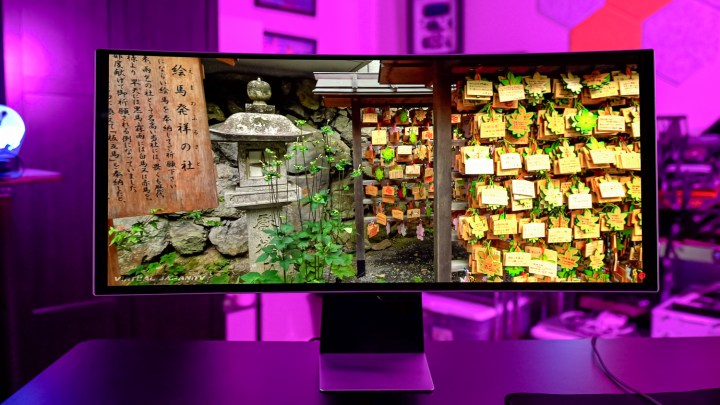
The other causality of QD-OLED panels is text clarity. When you look very closely at text on a QD-OLED panel, you can see a slight amount of fringing on fine, high -ontrast details like black text on a white background. It’s hard to notice without a LCD panel to compare it to, though, and I use a QD-OLED display every day without issue. On top of that, OLED panels aren’t great for extended desktop use due to the minor risk of burn-in. It’s not a problem for most people, but still important to note.
You’ll want to run the monitor in HDR most of the time. Peak brightness in HDR is slightly higher for the full screen, topping out at 272 nits. It’s the hotspot brightness that matters, though. For 10% of the screen, the display delivered 448 nits, and for a 3% window, 902 nits. Samsung doesn’t make any bold brightness claims, but it’s great to see the display can deliver bright highlights for small portions of the screen.
Color accuracy isn’t great in HDR, as is expected, but Samsung includes a ton of options to tweak the quality of the picture, even with HDR turned on. More on that later.
Gaming is the real winner

It’s hard to play on anything else once you switch to an OLED gaming monitor. It’s a best of both worlds panel, with stunning HDR for cinematic gaming and remarkably low response times for competitive titles. It’s also hard to argue with the 21:9 aspect ratio, which I find much more immersive for games like Cities: Skylines and Ratchet and Clank: Rift Apart.
Samsung claims a response time of 0.03 milliseconds, and while that’s a best-case-scenario metric, it still illustrates how fast OLED is. You’re looking at sub-1ms response times in real use due to the fact that individual pixels have control over the light they emit. Combined with the 175Hz refresh rate, the OLED G8 delivers top-notch motion clarity that’s only rivaled by displays like Alienware’s 500Hz gaming monitor.
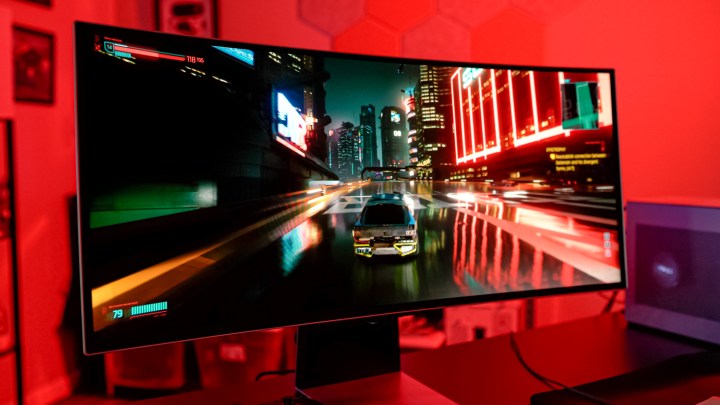
You can’t ignore the HDR performance, either. When playing games like Cyberpunk 2077, Marvel’s Spider-Man, and Baldur’s Gate 3, it feels like they were made for a QD-OLED display. That’s true even if you keep HDR turned off, with the perfect black levels of QD-OLED still offering excellent contrast.
The best gaming experience you can get right now is on a monitor like the OLED G8. It’s not the only display with this panel — I personally use Alienware’s 34 QD-OLED for gaming and both MSI and Philips have their takes on this panel as well. The OLED G8 joins their ranks.
An OS that’s more than Netflix
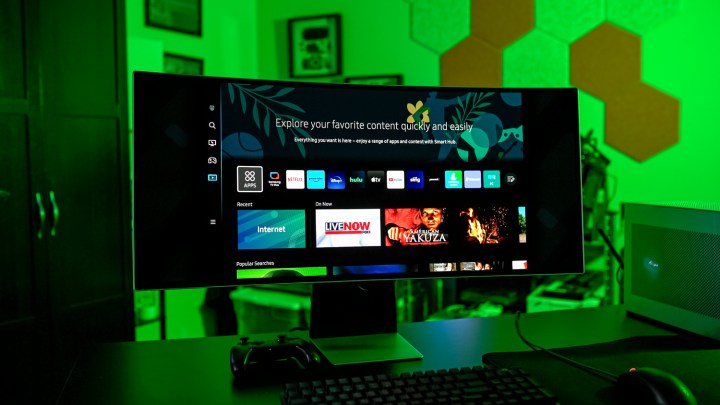
This is the point where I’d normally stop a monitor review, but there’s a whole other world for the OLED G8. It comes with Samsung’s Tizen operating, similar to the Samsung Smart Monitor M8. At a high level, that opens up apps like Netflix and YouTube, along with Samsung’s TV Plus, which offers some channels for free. It also unlocks Samsung’s Game Hub, offering cloud gaming through Xbox Game Pass and GeForce Now directly through the display.
Those extras aren’t too important for a gaming display, but they don’t hurt. The boost with the Tizen OS is all of the extras it brings. It comes with Bluetooth and Wi-Fi built into the display, so you can hook up a game controller and get software updates directly through the display. It also opens up options like Apple AirPlay, allowing you to stream content to the screen even without a PC hooked up.

There are several ways to navigate the OS, too. As mentioned, you can connect a Bluetooth controller, but you can also use the included remote, a joystick on the back of the display, and even your phone. You can also use your phone for Samsung’s Smart Calibration to quickly tweak the colors of the display.
Outside of controlling the monitor, you can use Bluetooth to connect speakers or headphones directly to the display. The built-in speakers are solid, a clear step above what you find in most monitors, but being able to use the same audio for different sources is the real plus here.
I wrote off the Tizen OS when the OLED G8 was first announced, and I imagine I wasn’t alone. If you just focus on the apps, it’s a worthless addition considering you’ll be connecting a PC to this display in the vast majority of cases. The extra settings the OS enables are compelling, though, and they help justify the OLED G8’s higher-than-average price.
Somehow worth the premium
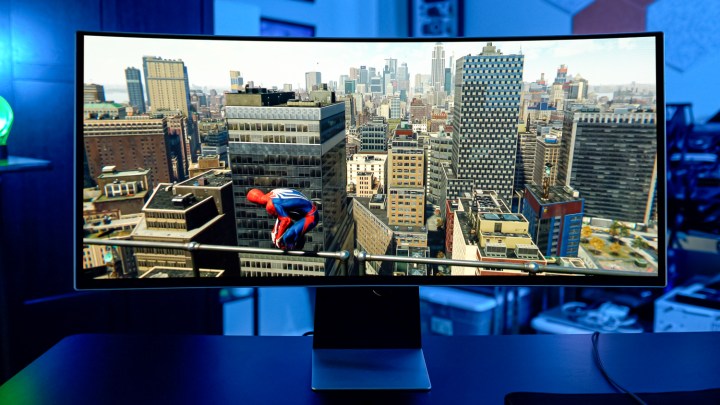
I’ve ignored the price of the OLED G8 throughout the majority of this review, and that’s where it falls short. When Samsung first announced the monitor, it was clear that it would be dead on arrival due to its $1,500 price tag. Even going into this review with that looming over it, the Odyssey OLED G8 has changed my mind.
It’s worth a premium over the Alienware 34 QD-OLED, which is its closest competitor. It’s not worth a $500 premium, but the OS and exceptional build quality justify spending a little more. And thankfully, Samsung has brought down the price of the display. In the U.S., it’s readily available for between $1,200 and $1,300 — at the time of writing, I even found a deal for $1,000.
Even so, the decision between the Alienware 34 QD-OLED and the OLED G8 isn’t an easy one. It depends on the prices when you shop for a display, but I imagine most people will be able to save some money with the Alienware monitor and still get an incredible experience. The OLED G8 fills in as a premium experience that offers the same image quality with extra features.
Editors’ Recommendations

